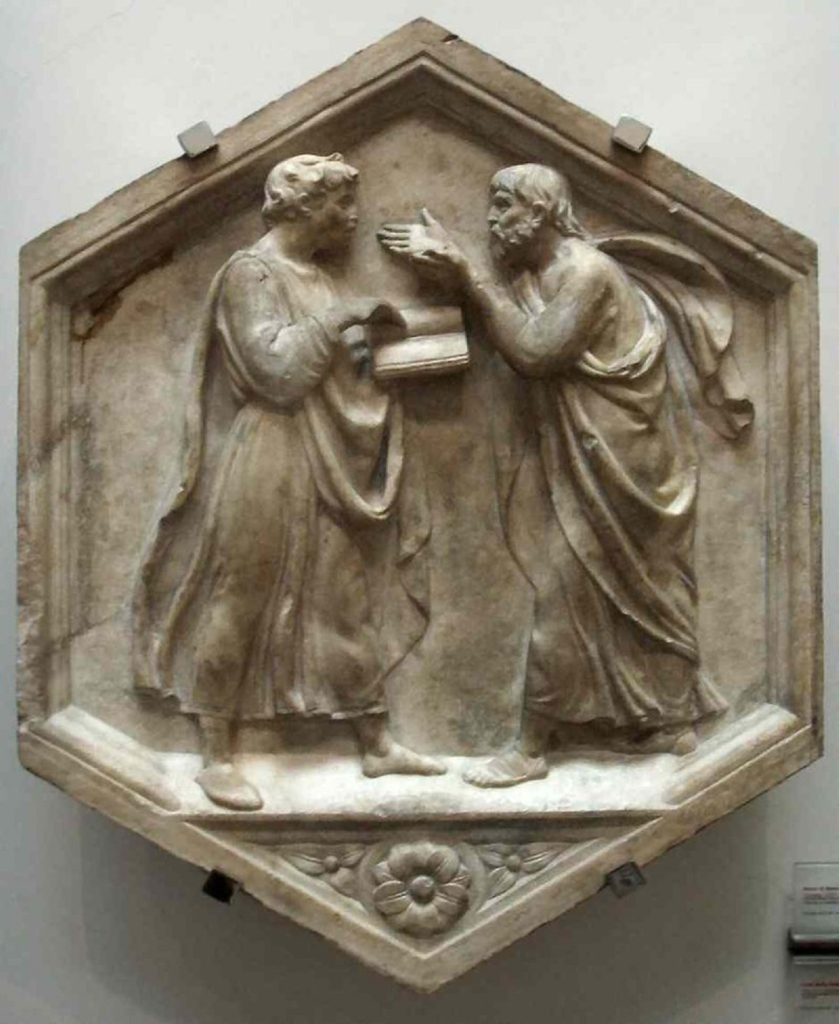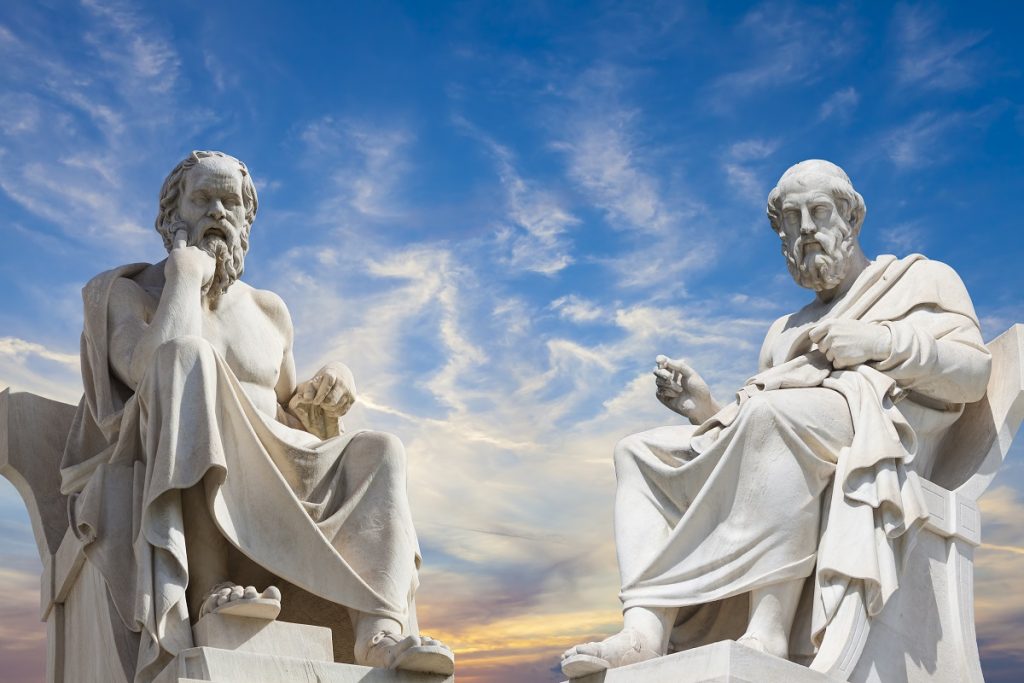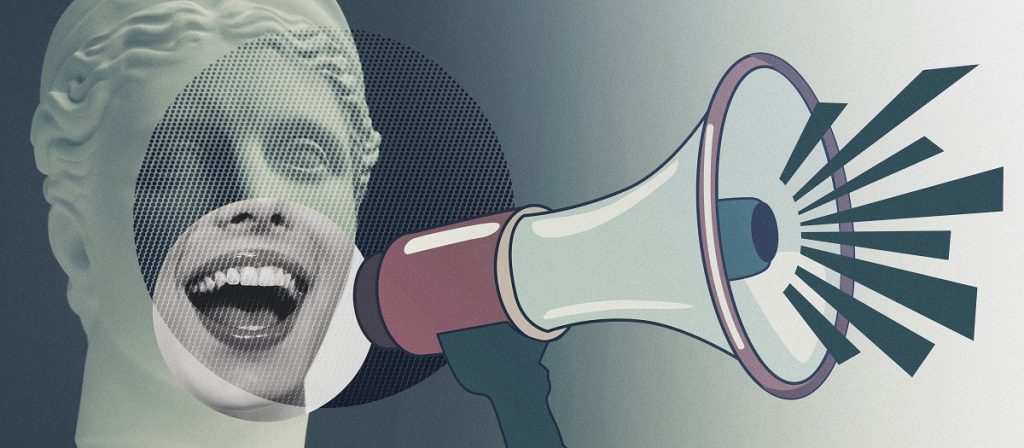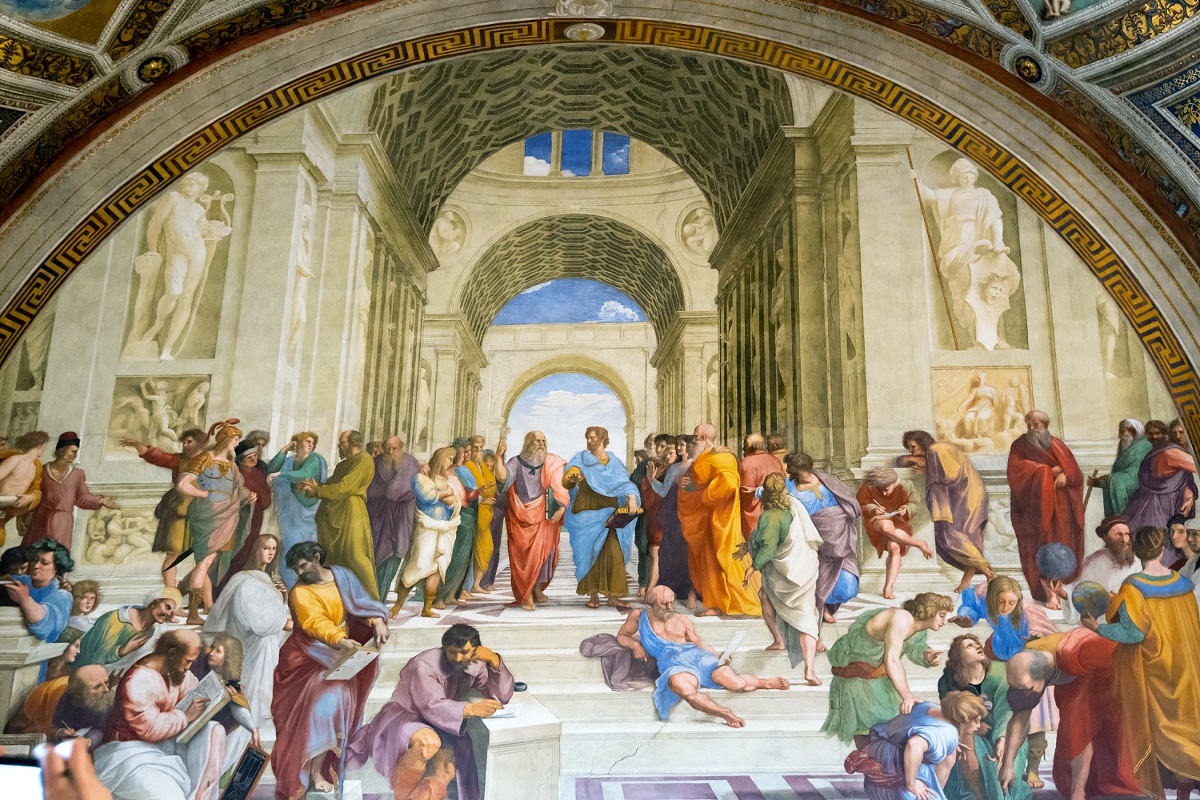Rhetoric studies the techniques speakers or writers use to inform, persuade, or motivate their audience. Along with grammar and logic, it is one of the three ancient arts of discourse. The principles developed in ancient Greece and honed over time have influenced the training of Western orators, lawyers, counselors, historians, politicians, and poets.
Rhetoric is a fundamental art of persuasion studied and practiced for over 2,000 years. Its roots can be traced back to Athens in ancient Greece, where it was considered an essential educational component for those seeking to participate in public life.
Today, rhetoric remains an important study area, with scholars examining its historical development and continued relevance in contemporary society.
What is Rhetoric?
Rhetoric is the art of using language effectively and persuasively. It involves studying how language communicates ideas, influences opinions, and motivates action. Rhetoric includes the use of techniques such as ethos (credibility), logos (logic), and pathos (emotion) to create persuasive arguments.
This skill has been valued throughout history, with the ancient Greeks and Romans developing and practicing complex rhetorical theory.
Today, rhetoric plays a vital role in fields such as politics, law, marketing, and everyday communication.

The Art Of Persuasion
The study of rhetoric evolved and spread throughout the ancient world, becoming an integral part of the Roman education system and the foundation of medieval education in Europe. Rhetorical tradition experienced a resurgence during the Renaissance, with scholars and writers exploring its potential for artistic and political purposes.
At its core, the definition of rhetoric is the art of persuasion. This involves a wide variety of strategies and techniques, including figures of speech, such as metaphors and similes, that create vivid and memorable images in the minds of audiences.
What Is The History Of Rhetoric?
Examples of rhetoric can be found in Mesopotamia (c. 2200 C) and Egypt (c. 2080–1640 BC), but it developed as a science in ancient Greece in the 5th century BC. The Greek philosopher Aristotle is often credited with developing the first comprehensive system of rhetorical theory outlined in his work Rhetoric.
Before this, rhetoric was used in the Greek city-states as a means of public persuasion and debate. Artistole’s work influenced the study of rhetoric for centuries.
The Sophists, a group of traveling teachers, also significantly developed rhetoric during this time. Rhetoric later became an important part of Roman education and continued to evolve through the medieval and Renaissance periods. Today, rhetoric remains vital in communication, philosophy, and literature.
“Rhetorica” is the Latin term for rhetoric used by ancient Roman writers to refer to the study of persuasive speech. Rhetorical analysis is a key method of studying rhetoric, involving the examination of persuasive texts to understand their strategies and techniques.
Rhetoric continued to evolve during the Roman Empire, the medieval period, and the Renaissance, and it remains an important area of study in communication, philosophy, and literature today. The study of rhetoric has contributed significantly to developing public speaking, political communication, and other forms of persuasive discourse.
Classical rhetoric theory and practice focused on the principles and techniques of persuasion, with an emphasis on clear and effective communication. Classical rhetoric is based on three primary modes of persuasion, known as logos (logic), pathos (emotion), and ethos (speaker’s credibility.)
Who Are Some Of The Greats In The History Of Rhetoric?
There are many greats in the history of rhetoric, but here are some notable figures:
Aristotle
400-320 BC
The Greek philosopher Aristile’s Rhetoric is considered one of the most influential works. Aristotle defined Rhetoric as the “available means of persuasion.” His work is foundational in the development of rhetoric and linguistics.
He also made many contributions to the fields of physical science (physics, biology, geology, zoology, meteorology), the arts (aesthetics, poetry, drama, music), social science (psychology, politics, economics, government), and philosophy (metaphysics, logic, ethics).

Isocrates
436-338 BC
Isocrates was a Greek rhetorician who emphasized the importance of education and civic responsibility. H believed that rhetoric was a crucial tool for promoting justice and democracy, and he sought to train young people in the art of persuasive speech.
Phaedrus
444 – 393 BC
Another important figure in the history of rhetoric, Phaedrus is known for his dialogue on love and the nature of rhetoric. In this dialogue, Socrates and Phaedrus discuss the power of rhetoric, its potential to manipulate and deceive, and its ability to inspire and enlighten.
The polis, or city-state, was an important context for the practice of rhetoric in ancient Greece. Public speaking and debate were essential for civic participation and political leadership, and the polis provided a forum for citizens to engage in these practices.
Plato And Socrates
Plato (427-347 BC) was not famous for his rhetoric. He was quite critical of the practice, which he saw as deception and manipulation. Plato believed that rhetoric was more concerned with winning an argument than with seeking the truth, and he felt that it could be used to sway people’s emotions rather than appeal to their reason.
In his dialogue “Gorgias,” Plato portrays the Sophist philosopher Gorgias as a master of rhetoric who uses his skills to manipulate people rather than to seek the truth. Instead of rhetoric, Plato emphasized the importance of philosophy as a means of discovering the truth and promoting justice.
Socrates (469-399 BC) was not particularly noted for his rhetoric either like some of his contemporaries were. Socrates often claimed he had no real knowledge or expertise and was known for using irony and questioning rather than making persuasive speeches.
Instead of trying to persuade others to his point of view, Socrates was more interested in engaging in philosophical dialogue to uncover the truth.

Cicero
106-43 BC
Roman politician Cicero is perhaps the best-known orator who wrote extensively on rhetoric and is known for his speeches and writings. His writings sparked the cultural innovations of the Renaissance.
Quintilian
35-100 AD
This Roman rhetorician wrote “Institutio Oratoria,” a comprehensive guide to rhetorical theory and practice. Quintilian emphasized the importance of education and training in the art of rhetoric, and his work has had a lasting influence on the study of rhetoric and communication.
How Has The Use Of Rhetoric Changed Over Time?
The use of rhetoric has changed significantly over time. In ancient Greece, rhetoric was primarily used in Athenian politics, public debate, and persuasion. During the Roman Empire, rhetoric became more formalized and was used in legal and political contexts.
In the Middle Ages, rhetoric was primarily used in religious discourse. For example, St. Augustine, a 6th-century Christian theologian, wrote On Christian Doctrine, which applied rhetorical principles to interpreting and communicating biblical texts.

Over the centuries, many other great lights of rhetoric emerged. One example is Kenneth Burke, a 20th-century American literary critic and philosopher, who developed a comprehensive theory of rhetoric that focused on how language shapes perception and identity.
He and his colleague A. Richards at Syracuse University developed new approaches to studying rhetoric in the 20th century. Their “new rhetoric,” focused on persuasive communication’s social and cultural context.
What Is The Difference Between A Speech And A Rhetoric?
A speech is a verbal presentation given by an individual to an audience on a particular topic or issue. It can be informative, persuasive, or entertaining and typically has a clear beginning, middle, and end. Rhetoric, on the other hand, refers to the art of using language effectively and persuasively. It includes studying how language communicates ideas, influences opinions, and motivates action.
A speech is considered an example of rhetoric if it employs rhetorical techniques to achieve its purpose. In other words, while a speech is a specific instance of public speaking, rhetoric is the broader framework of persuasive communication applied to various forms of discourse.
Other Aspects Of Rhetoric
One of the earliest forms of rhetorical practice was deliberative rhetoric, which focused on persuading audiences to take a specific course of action. This form of rhetoric was popular in ancient Greece and Rome, where it was used to influence political decisions and debates.
Another form of rhetorical practice is epideictic rhetoric, focusing on praise or blame. Epideictic rhetoric was used in public ceremonies, such as funerals or festivals, and was designed to inspire and move audiences through powerful language and emotional appeals.
How Has Rhetoric Influenced Public Speaking?
The art of rhetoric has profoundly influenced public speaking throughout history. It has provided speakers with a framework for organizing and persuasively presenting their ideas. By studying rhetoric, speakers learn how to use language to appeal to their audience’s emotions, values, and beliefs.
Rhetorical techniques such as repetition, parallelism, and rhetorical questions are commonly used in public speaking to enhance the impact of a message. Its study has also helped to elevate public speaking as an important skill in many fields, including politics, education, and business.

Rhetoric By The Numbers
The Three Arts Of Discourse
The Three Arts of Discourse refer to the three primary elements of effective communication in rhetoric. These are:
- Invention: The art of developing compelling arguments and ideas to persuade the audience. This involves selecting the most appropriate evidence and reasoning to support a claim.
- Arrangement: The art of organizing and structuring arguments and ideas to create a coherent and persuasive message. This involves considering the best order for presenting information and using rhetorical devices such as repetition, contrast, and parallelism to enhance the impact of a message.
- Style: The art of using language effectively to enhance the persuasive power of a message. This involves selecting the most appropriate words and phrases to convey ideas and using rhetorical devices. These devices are metaphors, similes, and allusions to create memorable and impactful messages.
Aristotle’s Three Persuasive Audience Appeals
Aristotle identified three main persuasive appeals that speakers use to influence an audience. These are:
- Ethos refers to how the speaker’s credibility and trustworthiness persuade the audience. Speakers establish ethos by demonstrating their expertise, authority, or moral character on a particular topic.
- The use of pathos involves emotional appeals to persuade the audience. A speaker uses pathos by appealing to the audience’s emotions, values, and beliefs to create a connection and elicit an emotional response.
- Logos are logical appeals to persuade the audience. A speaker uses logos by presenting evidence, reasoning, and arguments clearly and logically to convince the audience of a particular point of view.
Aristotelian ideas have profoundly influenced Western thought and continue to be studied and debated by scholars today.
The Five Canons Of Rhetoric (The Phases Of Developing A Persuasive Speech)
The Five Canons of Rhetoric are the five phases of developing a persuasive speech. These canons were created by the Roman orator Cicero and expanded upon by other rhetoricians. The Five Canons of Rhetoric are:
- Invention: Ideas and arguments to persuade the audience. It involves brainstorming and researching to find the most persuasive and relevant discussions.
- Arrangement: Organizing ideas and arguments logically and effectively. It involves determining the most persuasive order for presenting the views and using transitions and signposts to guide the audience through the speech.
- Style: This involves choosing the most effective language and tone to convey the message. It employs rhetorical devices such as metaphors, similes, and allusions to create memorable and impactful messages.
- Memory: This involves memorizing a speech without relying on notes. It uses techniques like repetition and visualization to help remember key points.
- Delivery: Speakers must use a clear, confident, and engaging manner. They should use effective body language, vocal variety, and eye contact to connect with the audience and convey the message effectively.
Other Aspects Of Rhetoric
One of the earliest forms of rhetorical practice was deliberative rhetoric, which focused on persuading audiences to take a specific course of action. This form of rhetoric was popular in ancient Greece and Rome, where it was used to influence political decisions and debates.
Another form of rhetorical practice is epideictic rhetoric, focusing on praise or blame. Epideictic rhetoric was used in public ceremonies, such as funerals or festivals, and was designed to inspire and move audiences through powerful language and emotional appeals.
An important aspect of the study of rhetoric is dialectic, which involves logical argumentation to arrive at the truth. Another key concept in rhetoric is the enthymeme, a type of argument that relies on an implicit assumption or premise.
Bibliographies And Cooking!
The development of bibliographies provides comprehensive listings of works on rhetorical theory and practice. They allow scholars to trace the evolution of rhetorical thought over time and across different cultures.
While rhetoric is often associated with public speaking and political discourse, it is applied to various topics and formats. For example, cookery writing could be rhetorical as it uses language and imagery to persuade readers to try new recipes and ingredients.

